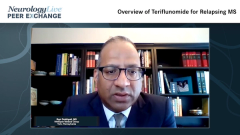
Considerations for the Use of Fumarates in Relapsing MS
Experts in the field of multiple sclerosis provide insight into the fumarates as a viable oral option for relapsing MS.
Episodes in this series

Fred D. Lublin, MD: Let’s move onto another class that has multiple agents, and that’s the fumarates, so dimethyl and monomethyl. Ravi, do you want to take us briefly through those?
Ravi Dukkipati, MD: Sure, thank you. The fumarates, as a class, were introduced after the S1Ps [sphingosine-1-phosphates], and I believe here in the United States at least, they came around 2011, 2012. Initially there was dimethyl fumarate, and then there was a newer iteration of dimethyl fumarate, diroximel fumarate. These have established themselves quite well, in the United States and internationally, as a viable oral option for patients with relapsing remitting multiple sclerosis [MS]. I would characterize their efficacy as modest in comparison to the S1Ps and the B-cell depleters that we just discussed. They are relatively safe. The main evolution, in terms of dimethyl fumarate to the newer diroximel fumarate, isn’t so much about efficacy, but diroximel fumarate demonstrates better tolerability. The one concern with the fumarates has been tolerability, namely GI [gastrointestinal] and flushing. But on the spectrum of agents, the fumarates represent a viable option for patients with mild to moderate relapsing forms of MS. I welcome thoughts from Gavin and Lauren on this.
Lauren Gluck, MD: This seems like, in my experience at least, the community neurologist’s DMT [disease-modifying therapy]. It is very easy to start. There aren’t a lot of monitoring requirements, before or during treatment. People don’t get strange infections from it, but they do get a lot of adverse effects. I think up to 40% of patients on dimethyl fumarate develop GI adverse effects like heartburn and stomachaches. Sometimes it’s helpful if they eat beforehand, sometimes it’s not. I think on average patients stay on it for about 2 years, but that is definitely a limiting factor. For all of the other new drugs and drug classes we have available, both in this low moderate efficacy range, to the S1Ps that are higher moderate efficiency, fumarates aren’t always my first choice for those reasons. But it is definitely an easy medicine to start and stop.
Ravi Dukkipati, MD: The other point to make is, as I pointed out, diroximel fumarate is a newer version of dimethyl fumarate. To Lauren’s point, these are very easy for a neurologist to initiate. There’s relatively little monitoring. Adherence can sometimes be a concern, at least from my perspective. These are BID [twice a day] formulations, and in the case of diroximel fumarate, the dosage is 4 tablets a day. So, while they are easy to initiate and require little monitoring, I think the real concern, back to what we talked about initially, is individualizing patient choices and choosing the right drug for the right patient, and optimizing efficacy. We must understand that we may be compromising efficacy in some cases with the use of this class of medication. I will also add that they are appropriate choices for patients with milder forms of MS.
Fred D. Lublin, MD: Thank you all for watching this NeurologyLive® Peer Exchange. If you enjoyed the content, please subscribe to our e-newsletters to receive upcoming Peer Exchanges and other great content right in your inbox. Thank you for joining us.
Transcript Edited for Clarity
Newsletter
Keep your finger on the pulse of neurology—subscribe to NeurologyLive for expert interviews, new data, and breakthrough treatment updates.










































